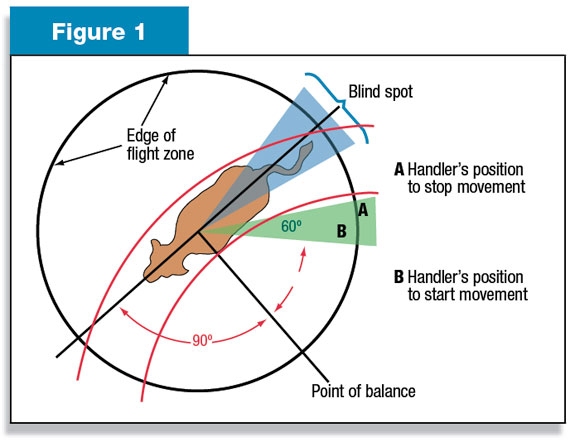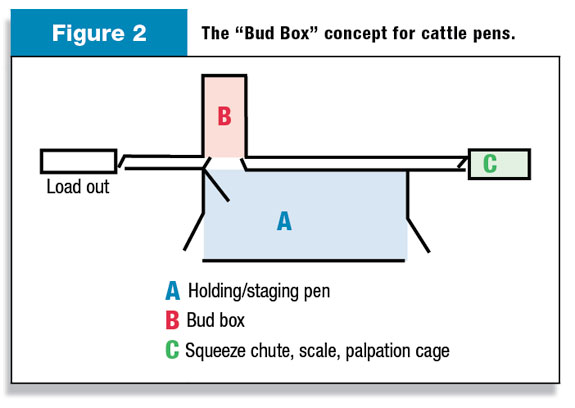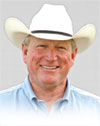The following is a list of handling pointers worthy of review before your next trip to the pasture or pens.
The role of a stockman is to create movement in cattle and then use position to control and manage that movement to the desired result. When cattle lose movement they become reluctant to work for you and excessive pressure and driving aids are more likely to be used to force movement within the cattle. Creating and managing movement is the key to low-stress cattle handling.
There are four basic principles of cattle behavior that when used properly can improve the ease and speed of working cattle while reducing stress and increasing efficiency. Those principles are:
Cattle want to see you.
An understanding of how cattle see is basic to getting cattle to respond to your position when working livestock. Cattle can see everywhere but directly behind them or a small blind spot in front of them. Movement toward the blind spot behind them causes an animal to turn its head to keep you in its line of sight. This can be used to your advantage to change direction of cattle or to your detriment if you are trying to drive cattle straight. When working from behind, it is important to keep moving side to side to prevent cattle from turning in an effort to keep you in its line of sight.
Cattle want to go around you.
Armed with this tip, position yourself such that, when they do go around you, they are pointed directly at the gate or destination you had in mind. They’ll think it was their idea to go there.
Cattle want to be with and will go to other cattle.
A herding instinct is natural among “prey’” animals. There is safety in numbers and they know it. As stockmen we can take advantage of this natural instinct as we work from the front of cattle. If you start the front, the back will follow. This is also why you should never leave one animal alone in a pen.
Cattle can think of only one thing at a time.
If cattle are thinking about anything other than what you are asking them to do, you will need to change their mind first before putting pressure on them. Fear is the biggest distraction, and any perception that the handler is a “predator” must be avoided.
Keeping these principles in mind, the following are a few suggestions that will improve the ease of handling cattle, whether they are being gathered from the pasture or processed through the corrals.
1. “The only way to work cattle quickly is slowly.”
(From a humorous book entitled “Don’t Squat With Your Spurs On.”) Patience is a great virtue when gathering and working cattle. When we get in a hurry, inevitably we put excessive or incorrect pressure on cattle, which usually results in an unintended reaction from the cattle. Then we get to ride (or walk) to the back and start over.
2. Work from the front to draw cattle to you.
This goes back to the basic principle No. 1.. Cattle can be easily controlled from the front if they are not afraid of a human. (If they are afraid, you are a long way away from being able to handle cattle using low-stress principles.) Working from the front helps keep cattle from wanting to turn back in an effort to keep you in their line of sight. By moving in and out of the flight zone and point of balance, cattle can be easily drawn forward and past you to get them to go where you need them to go.
Most people have seen this diagram outlining the flight zone and point of balance on a cow.

See Figure 1.
However, it is important to remember that these are all just in theory and each individual animal will react differently to body position within these zones. The manner in which you approach or enter these zones or points of balance will impact how the animal responds.
Where each animal’s point of balance falls varies greatly and is influenced by pressure in front or behind, the draw of cattle ahead or behind them and whether or not they are comfortable going by the handler. Suffice it to say that the point of balance on any given animal is not where it is drawn on this diagram.
Forget the angles and circles drawn below. It is the responsibility of each and every person handling cattle to be able to read and determine where these points are on each animal or herd you approach. About the only thing that is correct is the representation of the blind spot in the diagram. It is extremely difficult to stay in an animal’s blind spot. They will turn their head slightly to keep you in their line of sight. You can use this to your advantage to draw cattle to one eye or the other when working from behind.
3. Apply pressure when cattle have a place to go.
Low-stress livestock handling is not about handling cattle with no pressure. In fact the success of handling cattle correctly depends on knowing when and where to apply pressure and how much pressure to apply. The other key component to low-stress handling is setting the cattle up to go where you want them to go before you apply pressure. Just as important is to release the pressure as soon as the desired result is achieved.
4. Pressure from the side
This relates back to working from the front and down the side of an animal and not working from directly behind. The side of an animal is anything from the tip of the nose to the pin bones. Different animals respond differently to pressure and a good stockman must develop the ability to read livestock and anticipate the animal’s response before applying pressure.
5. Cattle must be comfortable to go by you and stay straight.
If cattle are not comfortable going by you, they will not work for you very well. Working from the front requires you to get the cattle able to pass you without balking or spooking. This simple principle facilitates penning, sorting and processing cattle.
The further forward you can make an animal’s point of balance, the easier it is to work and sort cattle. That is why using the draw of other cattle makes it easier to work and sort cattle in an alley or from one corral to another.
If an animal is abruptly stopped when it tries to pass the handler, it will be increasingly reluctant to try and come by the handler. That is why it is important to not stop forward motion abruptly but rather allow the animal time and room to turn back until it is time for you to release the pressure by stepping out and toward them and asking them to go by, simply by changing your body position.
This simple procedure of properly stopping and turning cattle away or back will make the difference in how cattle work throughout the day and their life. If the handler has to move past the point of balance as it is shown in the previous diagram to get an animal out of group, then it can put them out of position to control movement of the cattle behind them, further aggravating the problem.
The key is to position yourself such that when cattle go where they want to go, it is exactly where you intended for them to be.
6. Pressure cattle from behind only when absolutely necessary.
Like any “prey” animal, cattle cannot see directly behind themselves. If you assume a position directly behind cattle (in their blind spot), they will turn to one side or the other in order to see you. To “drive” cattle in a straight line, assume a position behind their point of balance (shoulder) and off to either side.
7. When working cattle, move in triangles.
Sounds odd, but it works. Move in straight lines. For example, if you work in an arch pattern behind the cattle, you will find them being drawn from side to side (and consequently walking in a zig-zag pattern) as they follow your movement. Move into their flight zone to create or correct movement.
Retreat from their flight zone to slow or stop movement.

8. Going with the flow of cattle slows them down or stops their movement.
It’s all about that point of balance – as you move in the same direction the cattle are traveling, when you approach a position parallel to their point of balance, they will slow down, and as you pass the point of balance they will stop and/or reverse their direction.
9. Going against the flow of cattle initiates or accelerates their movement.
The inverse or opposite of point No. 8. Ever filled the chute, then pressured the last animal in line to move the others forward? It’s likely he or she had no place to go and nothing happened. Next time, try leaving their flight zone, walk up ahead of the line, then re-enter the flight zone of the first in line and walk alongside the chute, front to back, and see what happens. We suspect that as you pass their point of balance, they will step forward.
The one in the front will pull the others forward.
10. Cattle work best when they are ready – you have to get them there.
Cattle (like husbands) are not mind readers. You have to teach, condition and prepare them. Unfortunately, today’s cattle owners are short on time and experienced labor, and consequently, don’t spend time with their cattle as did the stockmen of days gone by. Perhaps there’s not time to educate the entire existing herd, but quality time spent with replacement heifers will pay dividends for years to come.
Spend time with heifers (in both the pasture and the pens) when you want to, not just when you have to.
The days of “whoop and holler” cattle handling need to pass – quickly. Numerous others will handle your cattle after they have left your care. Bad habits and unruly behavior are learned. Make sure your cattle (calves) are started correctly. First impressions are critical – as Will Rogers once said, “You never get a second chance to make a first impression.”
Safety and wholesomeness of our food supply have long been important. Our preservation techniques have progressed from smoking, drying and salting, to canning, refrigeration and freezing, to vacuum packaging and most recently, to irradiation. The U.S. food supply is the safest and most wholesome on the planet.
Beef consumers remain interested in safety and wholesomeness, but are more concerned than ever before about where and how their food is produced.
When working slow and correct (see point No. 1), shouting, whistling, poking and prodding cattle is unnecessary.
In fact, they are counterproductive and distract cattle from what you really want them to do.This article originally appeared in the Texas A&M Agrilife Extension newsletter.

Ron Gill
Professor and Extension Livestock Specialist
Texas A&M University
r-gill1@tamu.edu
TOP: The success of handling cattle correctly depends on knowing when and where to apply pressure, and how much pressure to apply. Photo by Progressive Cattleman staff.






